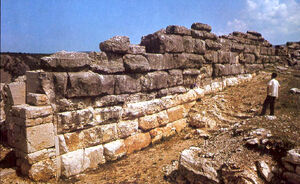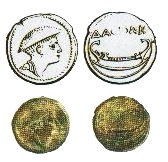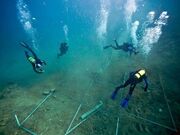
Walls of ancient Daorson, located at Ošanići near Stolac in Bosnia and Herzegovina.
Daorson (Ancient Greek; Δαορσών) was the capital of a Hellenised[1][2][3][4] Illyrian tribe called the Daorsi (Ancient Greek Δαόριζοι, Δαούρσιοι; Latin Daorsei). The Daorsi lived in the valley of the Neretva River between 300 BC and 50 BC. The remnants of Daorson can be found at Ošanići, near Stolac, Bosnia and Herzegovina.[5]
History[]

Illyrian Coin found at Daorson, Bosnia and Herzegovina
Daorson was built around a central fort or acropolis, surrounded by cyclopean walls made of huge[6] stone blocks (similar to those in Mycenae, in Greece).[5] The acropolis would have housed all of the important administrative, public and religious buildings. The defensive wall extending from southwest to northeast was 65 metres long, 4.2 metres wide, and from 4.5 to 7.5 metres high with doors and towers on both sides.[5] The Daorsi used the Greek language and alphabet and kept trading relations with the Greeks.[5] The remnants of numerous wine amphorae have been found, including some ceramic fragments. The most valuable of the finds is a bronze helmet decorated with a series of Greek mythological figures, including Aphrodite, Nika, Heli, Dionysius, Muse, Pegasus. The inscription on it is similar to the inscription on a helmet found in Macedonia.[5] The remnants of a granite sculpture of Cadmus and Harmonia have also been found. This piece includes an Illyrian relief with thirteen snakes and five pairs of eagle’s wings.[5] A small building housed a mint facility. Thirty-nine different coins were discovered in this building, the majority (29) depicted King Ballaios, who ruled after 168 BC. Nine of the recovered coins had a Greek inscription with an image of a boat.[5] Money was of immense importance to the Daorsi, allowing the tribe to remain independent while securing their business, cultural and trade links with other groups.[5][7]

Finding Illyrian amphorae at Desilo, within Hutovo Blato Nature Park
After the Daorsi were attacked by the Delmatae,[8] they joined Issa[9] in seeking the protection of the Roman state. The Daorsi abandoned Caravantius and fought on the side of the Romans, contributing with their strong navy. After the Illyrian Wars the Romans gave the Daorsi immunity.
Bibliography[]
- Wilkes, J. J. The Illyrians, 1992,ISBN 0631198075,
See also[]
- Neretva
- Počitelj
- Hutovo Blato
- Desilo
- Bregava River
- Blagaj
- Vrelo Bune
- Buna River
- List of ancient Illyrian cities
- List of ancient Illyrians
References[]
- ↑ The Art treasures of Bosnia and Herzegovina by Đuro Basler, Mirza Filipović, Sulejman Balić,1987,page 28,"Only to the south of there, in the River Neretva basin, had the influence of Hellenism taken root, principally among the Illyrian Daorsi who occupied"
- ↑ Grčki utjecaj na istočnoj obali Jadrana: zbornik radova sa znanstvenog skupa održanog 24. do 26. rujna 1998. godine u Splitu by Nenad Cambi,ISBN-9531631549,2002,page 432,"and the 3rd century BC when some of the indiginous tribes were fully hellenized"
- ↑ Institute of Archaeology bulletin by University of London. Institute of Archaeology - 1978,page 21
- ↑ Dalmatia: research in the Roman province 1970-2001 : papers in honour of J.J by David Davison, Vincent L. Gaffney, J. J. Wilkes, Emilio Marin,2006,page 21,"completely Hellenised town"
- ↑ 5.0 5.1 5.2 5.3 5.4 5.5 5.6 5.7 http://www.coe.int/t/dg4/cultureheritage/regional/see/IRPPSAAH/PTA%20Ljubljana/BH_22-PTA-APPROVED_web.pdf
- ↑ Urbano biće Bosne i Hercegovine - page 27 by Seka Brkljača - 1996, "Its name was Daorson. It belonged to the illyrian sphere. Its 46 meters of the old fortress are preserved"
- ↑ [1] Wilkes, J. J. The Illyrians, 1992,ISBN 0631198075,page 177,"... Two other coinages of Illyrian peoples are dated to the period following 168B(:. Those with the legend DAORSON with a galley on the reverse were produced by the Daorsi. ..."
- ↑ I greci in Adriatico, Volume 2 by Lorenzo Braccesi, Mario Luni, page 152, "The Daorsi suffered directly from the attacks of the Delmatae and were understandably one of the first peoples who had left Genthius half brother Caravantius and sought protection from the Roman state placing their armed forces at the disposal of the Romans. After the war they were rewarded by having been given immunity..."
- ↑ The magistrates of the Roman Republic - by Thomas Robert Shannon Broughton - 1960 - page 446, "Head of a commission sent, after the receipt of complaints from Issa and the Daorsi, to observe conditions in Illyria and Dalmatia"
